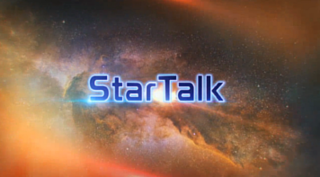
Space Quest is a series of six comic science fiction adventure games released between 1986 and 1995. The games follow the adventures of a hapless janitor named Roger Wilco, who campaigns through the galaxy for "truth, justice, and really clean floors".

Astrophysics is a science that employs the methods and principles of physics and chemistry in the study of astronomical objects and phenomena. As one of the founders of the discipline, James Keeler, said, astrophysics "seeks to ascertain the nature of the heavenly bodies, rather than their positions or motions in space—what they are, rather than where they are", which is studied in celestial mechanics.

Mark Crowe is an American video game designer, artist, and writer who developed several adventure games, mostly for Sierra On-Line and its subsidiary Dynamix. He later worked at Pipeworks Software as Studio Design Director. Crowe is best known for creating the Space Quest series, mostly with his fellow "Guy from Andromeda", Scott Murphy.

Elite Dangerous is an online space flight simulation game developed and published by Frontier Developments. The player commands a spaceship and explores a realistic 1:1 scale, open-world representation of the Milky Way galaxy, with the gameplay being open-ended. The game is the first in the series to attempt massively multiplayer gameplay, with players' actions affecting the narrative story of the game's persistent universe, while also retaining a single-player mode. Elite Dangerous is the fourth game in the Elite video game series. It is the sequel to Frontier: First Encounters, released in 1995, becoming the top selling game for Christmas of that Year.

Neil deGrasse Tyson is an American astrophysicist, author, and science communicator. Tyson studied at Harvard University, the University of Texas at Austin, and Columbia University. From 1991 to 1994, he was a postdoctoral research associate at Princeton University. In 1994, he joined the Hayden Planetarium as a staff scientist and the Princeton faculty as a visiting research scientist and lecturer. In 1996, he became director of the planetarium and oversaw its $210 million reconstruction project, which was completed in 2000. Since 1996, he has been the director of the Hayden Planetarium at the Rose Center for Earth and Space in New York City. The center is part of the American Museum of Natural History, where Tyson founded the Department of Astrophysics in 1997 and has been a research associate in the department since 2003.

Cosmos is a popular science book written by astronomer and Pulitzer Prize-winning author Carl Sagan. It was published in 1980 as a companion piece to the PBS mini-series Cosmos: A Personal Voyage with which it was co-developed and intended to complement. Each of the book's 13 illustrated chapters corresponds to one of the 13 episodes of the television series. Just a few of the ideas explored in Cosmos include the history and mutual development of science and civilization, the nature of the Universe, human and robotic space exploration, the inner workings of the cell and the DNA that controls it, and the dangers and future implications of nuclear war. One of Sagan's main purposes for both the book and the television series was to explain complex scientific ideas in a way that anyone interested in learning can understand. Sagan also believed the television was one of the greatest teaching tools ever invented, so he wished to capitalize on his chance to educate the world. Spurred in part by the popularity of the TV series, Cosmos spent 50 weeks on the Publishers Weekly best-sellers list and 70 weeks on the New York Times Best Seller list to become the best-selling science book ever published at the time. In 1981, it received the Hugo Award for Best Non-Fiction Book. The unprecedented success of Cosmos ushered in a dramatic increase in visibility for science-themed literature. The success of the book also served to jumpstart Sagan's literary career. The sequel to Cosmos is Pale Blue Dot: A Vision of the Human Future in Space (1994).

Kickstarter, PBC is an American public benefit corporation based in Brooklyn, New York, that maintains a global crowdfunding platform focused on creativity. The company's stated mission is to "help bring creative projects to life". As of February 2023, Kickstarter has received US$7 billion in pledges from 21.7 million backers to fund 233,626 projects, such as films, music, stage shows, comics, journalism, video games, board games, technology, publishing, and food-related projects.

Chris Pope is an American internet personality, video game developer, producer, social media professional, podcaster. Pope is best known by fans as the SpacePope.

Cosmos: A Spacetime Odyssey is a 2014 American science documentary television series. The show is a follow-up to the 1980 television series Cosmos: A Personal Voyage, which was presented by Carl Sagan on the Public Broadcasting Service and is considered a milestone for scientific documentaries. This series was developed to bring back the foundation of science to network television at the height of other scientific-based television series and films. The show is presented by astrophysicist Neil deGrasse Tyson, who, as a young high school student, was inspired by Sagan. Among the executive producers are Seth MacFarlane, whose financial investment was instrumental in bringing the show to broadcast television, and Ann Druyan, a co-author and co-creator of the original television series and Sagan's wife. The show is produced by Brannon Braga, and Alan Silvestri composed the score.
Video game development has typically been funded by large publishing companies or are alternatively paid for mostly by the developers themselves as independent titles. Other funding may come from government incentives or from private funding.
WebVTT is a World Wide Web Consortium (W3C) standard for displaying timed text in connection with the HTML5 <track> element.

Talking About Life: Conversations on Astrobiology is a non-fiction book edited by astronomer Chris Impey that consists of interviews with three dozen leading experts on the subject of astrobiology. The subject matter ranges from the nature and limits of life on Earth to the current search for exoplanets and the prospects of intelligent life in the universe. The book was published as a hardcover by Cambridge University Press in 2010.

Penny4NASA was a campaign run by the Space Advocates nonprofit, a nonpartisan organization seeking to promote the expansion of funding for the economic, scientific and cultural value of the United States' national space program by advocating an increase in the budget for the National Aeronautics and Space Administration to at least one percent of the United States Federal Budget. Penny4NASA attempted to promote public awareness of the NASA mission and budget by producing a series of outreach videos, as well as performing educational outreach via social media.
"Standing Up in the Milky Way" is the first aired episode of the American documentary television series Cosmos: A Spacetime Odyssey. It premiered on March 9, 2014, simultaneously on various Fox television networks, including National Geographic Channel, FX, Fox Life, and others. The episode is presented by the series host astrophysicist Neil deGrasse Tyson, directed by Brannon Braga, produced by Livia Hanich and Steven Holtzman, and written by Ann Druyan and Steven Soter.

StarTalk is a podcast on science, comedy, and popular culture hosted by astrophysicist Neil deGrasse Tyson and comedian Chuck Nice, with various other comic and celebrity co-hosts and frequent guests from the worlds of science and entertainment. Past co-hosts have included Colin Jost, Lynne Koplitz, Leighann Lord, Eugene Mirman, John Oliver, and Kristen Schaal. Guests have included astronaut Buzz Aldrin, actor Morgan Freeman, George Takei, comedian Joan Rivers, Arianna Huffington, YouTuber Sam Denby, Richard Dawkins and writer Mary Roach. StarTalk has a segment called Cosmic Queries, in which listeners send in questions about the universe to be answered on the show.

StarTalk is an American television talk show hosted by Neil deGrasse Tyson that aired weekly on National Geographic. StarTalk is a spin-off of the podcast of the same name, in which Tyson discusses scientific topics through one-on-one interviews and panel discussions. Space.com called it the "first-ever science-themed late-night talk show." The series premiered on April 20, 2015.

The Foo Show was an interactive virtual reality talk show developed by Foo VR and created by Will Smith. The first episode was released in April 2016.
Matthew John O'Dowd is an Australian astrophysicist. He is an associate professor in the Physics and Astronomy Department at the Lehman College of the City University of New York and writer and host of PBS Space Time on YouTube. He is a frequent guest on Science Goes to the Movies on CUNY TV and on StarTalk radio with Neil deGrasse Tyson.

Cosmos: Possible Worlds is a 2020 American science documentary television series that premiered on March 9, 2020, on National Geographic. The series is a follow-up to the 2014 television series Cosmos: A Spacetime Odyssey, which followed the original Cosmos: A Personal Voyage series presented by Carl Sagan on PBS in 1980. The series is presented by astrophysicist Neil deGrasse Tyson, written, directed, and executive-produced by Ann Druyan and Brannon Braga, with other executive producers being Seth MacFarlane and Jason Clark.















